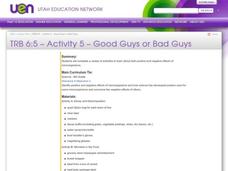Curated OER
What's a Swamp Good For?
Young scholars identify the function and value of wetlands. In this lesson on appreciating wetlands, students explain how different household items can represent different aspects of the wetlands.
Curated OER
ESL Colors Activity
In this ESL colors worksheet, students watch a video titled "The Colors of the Earth," then choose the correct colors to describe pictures and the correct animals being described.
Curated OER
The !Kung: Bushmen of the Kalahari
In this Kalahari worksheet, students read a 2-page selection about the !Kung and then respond to 3 short answer questions and complete 1 graphic organizer about the selection.
Curated OER
Where in The World Am I?
Students explore the concept of absolution location. In this geography skills lesson, students discuss how to identify and locate latitude and longitude. Students play a game to reinforce the skills.
Curated OER
Making Paper
Students brainstorm why trees are important to humans and the value of forests. They then participate in making paper in class. They may decorate the paper adding glitter, dried flowers, etc.
Curated OER
Cool Corals
Students explore corals and polyps. For this coral reef lesson students divide into groups and prepare a written report.
Curated OER
Forest Products
Students study forests and understand their reliance on forest products and examine their choices between renewable and non renewable resources. For this forest products lesson students read several articles, complete a short...
Curated OER
Groundwater as Part of the Water Cycle
Ninth graders study the effects of soil and rocks on filtering groundwater. In this groundwater lesson students complete a lab activity that includes sources of contamination.
Curated OER
Life is Weird
Students describe features of cold seep communities and list organisms that can be found in these communities. In this exploratory lesson students complete an activity and describe the process of chemosynthesis.
Curated OER
Fish Swimming--A Poem by Moniza Alvi
In this poetry analysis learning exercise, middle schoolers read the poem "Fish Swimming," and discuss the metaphors in the poem. Students complete eight activities based on the poem, including rewriting the subject of the poem and...
Curated OER
Twisted Vision
Students explain polarization vision and why some animals have it while others do not. They examine the reasons why it would be helpful for marine organisms to have polarized light.
Curated OER
Polar Day: Living in the Canadian North
Students study the Canadian North. In this Canadian North lesson plan, students study the physical characteristics and the lifestyles of people in that region. Students complete map making and creative activities that help them learn...
Curated OER
Animals Between the Sand Grains -- Meiofauna
Pupils begin the lesson by collecting sand at low tide from a local beach. They place each specimen on trays with a tiny amount of seawater. After a week, they can observe the meiofauna present in the sand through a microscope. They...
Curated OER
Aquatic Organisms
Students create a poster describing the five characteristics of a salt water organism compared to a fresh water organism.
Curated OER
Marine Debris
Students will perform experiments to examine if debris will float, or blow in the wind. They discuss the effects of these characteristics on marine debris.
Curated OER
Goals of the Diversity of Life Unit
Students are introduced to the unit on the importance of diversity of life and the role that interdependence plays in our worlds. this is part of a multi-lesson unit on the diversity of life.
Curated OER
It's For the Birds
Fifth graders examine how anatomical adaptations make it possible for a bird to survive in various habitats. They discuss and list birds and their unique characteristics, and create an imaginary bird, illustrating the environmental...
Curated OER
the New Explorers:Into the Depths
Students explore the self preservation mechanism that is inherent in the Great Lakes. They examine how scientists are studying Great Lakes, and what their predictions are for these national treasures.
Curated OER
Water Quality Monitoring
Learners comprehend the four parameters of water quality. They perform tests for salinity, dissolved oxygen, pH and clarity or turbidity. Students comprehend why scientists and environmental managers monitor water uality and aquatic...
Curated OER
Plants and Oxygen: Breathing
Second graders gain an understanding of how plants produce oxygen and that the oxygen we breathe comes from trees and plants. After a lecture/demo, 2nd graders discuss the ways plants produce oxygen and the detrimental effects of cutting...
Curated OER
Leaving Home
Learners explain the importance of larval dispersal and retention to populations. They collect data on organisms and examine it.
Curated OER
The New Explorers: Environmental Swat Team
Students follow scientists into the dry forest of Bolivia as they track and record the different species of mammals, birds, insects and plants that would be lost if the forests disappear.
Curated OER
Silting Situations
Students study the concept of sedimentation, the process of silting as it effects a man-make lake such as the Kansas-Lower Republican Basin.
Curated OER
Good Guys or Bad Guys
Sixth graders complete a variety of activities to explore both positive and negative effects of microorganisms. They, in groups, engage in a series of experiments which illustrate the effects of certain molds.























